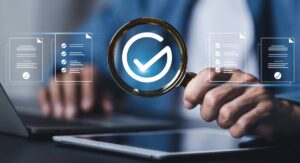Have you ever had a project that seemed one wrong move away from falling apart? If so, you need the critical path method (CPM).
CPM shows you the fastest, most efficient route to finish everything on time. This route is the critical path in project management that zeroes in on the sequence of crucial tasks that can make or break your project’s timeline. By mastering CPM, you can ensure that these tasks are prioritized and completed on time, keeping even the most complex projects on track.
To deepen your knowledge and skills in this area, consider checking out this project management course.
Ready to get a grip on your projects? Let’s dive in.
What is the Critical Path Method?
The critical path method, or critical path analysis (CPA), is your go-to technique for keeping projects on track. It is a roadmap that shows the exact sequence of tasks you must complete to finish your project on time.
It helps you determine which tasks are critical to the project’s timely completion and which can be flexibly scheduled.
Here is how CPM works: The critical path in project management maps out all your tasks and their dependencies, then calculates the longest path of tasks you must complete on time to avoid delays. This path sets the shortest possible duration for your project. By identifying which critical tasks are on this path, you can allocate resources smartly, tackle potential delays head-on, and keep everything running smoothly. It is like having the ultimate cheat code to ensure every part of your project flows seamlessly and hits its deadline.
Also Read: What is a Feasibility Study?
When to Use Critical Path Analysis?
You should find the critical path in project management when you have:
- Complex Projects with Many Dependencies and Tasks
- Tight Deadlines
- Limited Resources (time, money, or people)
- Potential Risks, Bottlenecks, or Project Delays
- Large Teams and Multiple Stakeholder Involvement
- Long-Term Projects or Goals
How to Find Your Critical Path in Project Management?
To find the critical path in your project, follow this process:
- List All Activities: List every task required to complete your project. Include every activity, no matter how small.
- Determine Task Durations: Next, estimate how long each task will take. Be realistic and precise. This step is crucial because it affects the entire timeline.
- Find Dependencies: Now, identify which tasks rely on others. Some tasks cannot start until another one finishes. This stage is where you connect the dots. Think of it like dominoes – one falls, the next can go.
- Create a Network Diagram: Draw a diagram or flowchart to visualize the sequence and dependencies of tasks. This chart helps you see which tasks run in parallel and which are sequential.
- Make a Project Schedule: Create a schedule that includes tasks, durations, and dependencies. For this step, you can use tools like Gantt charts or project management software.
- Identify All Possible Paths: A path is a sequence of activities from the start to finish of the project. Using the network diagram, identify all possible paths.
- Calculate the Duration of Each Path: Add up the duration of all activities in each path. This step will give you the total time to complete each path.
- Identify the Longest Path (Critical Path): Find the path of tasks through the diagram that takes the most time to complete. This sequence determines your project’s minimum timeline. If any task on this path gets delayed, the whole project slips.
- Figure out the Float Time: Float is your wiggle room. It defines how much a task can be delayed without affecting the project timeline.
- Monitor and Adjust: As the project progresses, monitor the critical path. If tasks are delayed or completed earlier, update the path to reflect the new project timeline and stay on track.
By understanding and managing the critical path method in project management, you can ensure timely completion and efficient resource use. This method involves pinpointing crucial tasks and ensuring nothing derails them.
Also Read: Project Management Documentation
An Example of Critical Path Method
To explain how CPM in project management works, consider a simple example of planning a product launch project. Here is the breakdown of the steps to find the critical path in this project:
#1. Project Tasks and Durations:
- Market Research: 14 Days
- Product Development: 30 Days
- Prototype Testing: 21 Days
- Marketing Campaign: 21 days
- Launch Event Planning: 14 Days
#2. Task Dependencies:
In the product launch project:
- Product Development can only start after Market Research is completed.
- Prototype Testing can only begin once Product Development is finished.
- Marketing Campaign can only start after Product Development is completed.
- Launch Event Planning can only begin after Prototype Testing is finished.
#3. Create the Network Diagram:
- Market Research (14 days) –> Product Development (30 days)
- Product Development –> Prototype Testing (21 days)
- Product Development –> Marketing Campaign (21 days)
- Prototype Testing –> Launch Event Planning (14 days)
#4. Project Timeline or the Critical Path Schedule (Sequence of Tasks Based on Dependencies):
- Start with Market Research:
- It takes 14 days to complete
- Next, Product Development:
- After market research, product development starts
- It takes 30 days
- Then, Prototype Testing:
- Begins right after product development finishes
- Takes 21 days
- After this, launch event planning can begin
- Marketing Campaign:
- This step also starts after product development finishes but runs parallel to prototype testing. However, this task does not directly affect the next task in the sequence.
- Takes 21 days
- Finally, Launch Event Planning:
- Begins after prototype testing finishes
- Takes 14 days
#5. Critical Path Analysis:
Let us identify all possible paths:
Path 1:
- Market Research (14 Days) → Product Development (30 Days) → Prototype Testing (21 Days) → Launch Event Planning (14 Days)
- Total Duration: 14 + 30 + 21 + 14 = 79 Days
Path 2:
- Market Research (14 Days) → Product Development (30 Days) → Marketing Campaign (21 Days)
- Total Duration: 14 + 30 + 21 = 65 Days
So, the critical path is:
- Market Research → Product Development → Prototype Testing → Launch Event Planning
- Total Duration on Critical Path: 79 Days
#6. Float Time:
- Float time is how much a task can be delayed without affecting the project completion date.
- For the product launch project:
- Market Research: No float (must finish on time).
- Product Development: No float (must finish on time).
- Prototype Testing: No float (must finish on time).
- Launch Event Planning: No float (must finish on time).
- Marketing Campaign: Has 21 days of float (it can be delayed by 21 days).
In summary, this means that the critical path for this product launch project is the sequence of tasks that takes 79 days to complete. The tasks on this path dictate the total duration of the project. Any delay in these tasks will push back the completion of the project. However, the Marketing Campaign can be delayed by up to 21 days without affecting the project.
This example shows how CPM in project management helps us pinpoint which tasks are crucial, ensuring we keep everything on schedule and deliver the project on time.
Also Read: Exploring the Role of a Scrum Master in Project Management
What is the Importance of CPM in Project Management?
The critical path method is like the GPS for project management. It does not just show you the way; it highlights the fastest route to reach your project goals. Here is why it is significant:
- At its core, CPM helps you identify the most critical tasks you must complete on time to keep the project on track. It is the backbone of any successful project management plan. When you know your critical path in project management, you can focus on planning the tasks that truly matter.
- CPA becomes even more valuable for projects stretching over months or even years. It helps you focus on the key milestones and prevents you from getting sidetracked by less important tasks.
- CPM in project management also helps you manage resources more efficiently. You can divide your resources where they count by identifying critical tasks and those with some wiggle room (float). This prevents bottlenecks and ensures your team members know exactly what to do and when.
- Another critical aspect of the CPM is its ability to provide early warning signs. This predictability allows you to take corrective action before it is too late.
- Lastly, CPM in project management keeps everyone on the same page. It provides a visual representation of the project timeline and task dependencies. This visibility is crucial for your team to know what needs to happen and when.
In other words, when you understand your critical path in project management, you gain the upper hand. You know where to divide resources, where to apply pressure, and where you can afford to take your foot off the gas. This level of control reduces risks and increases the chances of project success.
What are the Benefits of the Critical Path Method in Project Management?
Now, let’s talk about the benefits that CPM in project management brings to the table.
First off, CPM gives you clarity and a crystal-clear schedule. By identifying the critical path in project management, you can predict the project’s timeline and set realistic deadlines.
Second, CPM enhances your decision-making. When you know which tasks are critical, you know which tasks to prioritize, which can wait, and where to allocate resources. This leads to better, faster decisions that keep your projects on track.
Next, it makes teamwork smooth. When everyone knows the critical path, coordination becomes second nature. There’s no stepping on each other’s toes. Every task flows into the next, like clockwork.
Then, there’s cost control. By keeping an eye on the critical path, you can avoid unnecessary expenses because you only have to focus on what moves the needle.
CPM also helps you dodge risks. By mapping out the critical path, you can predict potential delays before they happen. This proactive approach avoids last-minute surprises and keeps your project timeline intact.
And let us remember flexibility. If things change—and they will—you can adjust the critical path without losing momentum.
In a nutshell, CPM in project management helps you gain control, improve efficiency, and increase the chances of project success. That is the kind of impact every project manager should aim for.
If you are serious about mastering CPM and elevating your project management skills, check out this project management course. It is the next step to ensuring your projects run like clockwork. Enrolling in this course will tell you the difference between flying blind and navigating projects with a clear, precise map.
Also Read: AI for Project Management: Creating More Efficiency, Accuracy, and Better Results
Critical Path Method (CPM) vs. PERT: What’s the Difference?
The critical path method (CPM) and the program evaluation and review technique (PERT) might seem similar. But they serve different purposes and suit different projects:
- The CPM is best for a project with a well-defined scope and duration. It helps you identify the longest sequence of tasks that must be completed on time to finish the project. This sequence optimizes timelines and resources.
- However, PERT is ideal for projects with uncertain task durations and projects where risk management is necessary. Unlike CPM, PERT does not assume you know how long each task will take. Instead, it uses time estimates to calculate the average time required to complete each task.
When to Use Which?
- Use CPM when you understand your task durations and want to optimize your timeline. Perfect for construction projects, manufacturing processes, or any project where you have done this before and know the ropes.
- Use PERT when your project involves a lot of guesswork, like new product development or research projects. It helps you manage the uncertainty and potential delays.
Also Read: Exploring Top AI Project Management Tools
Nail Your Projects with the Critical Path Method
The critical path method (CPM) is not just another project management buzzword—it’s your ultimate strategy for keeping projects on point and on time. It cuts through the noise and tells you exactly what needs to be done and when. So you can dodge the common pitfalls of project delays and scope creep.
Do you want to find the best critical path in project management? Enroll in a project management program and take your next step in understanding CPM. It covers everything from foundational concepts to hands-on knowledge — everything taught by industry experts. You’ll also earn a prestigious certificate, validating your knowledge and skills.
You might also like to read:
What is Enterprise Resource Planning, And How Does It Help Organizations?
What Are Network Diagrams in Project Management, and Why Are They Effective?
What is the Pomodoro Technique & How Does It Help in Time Management?







